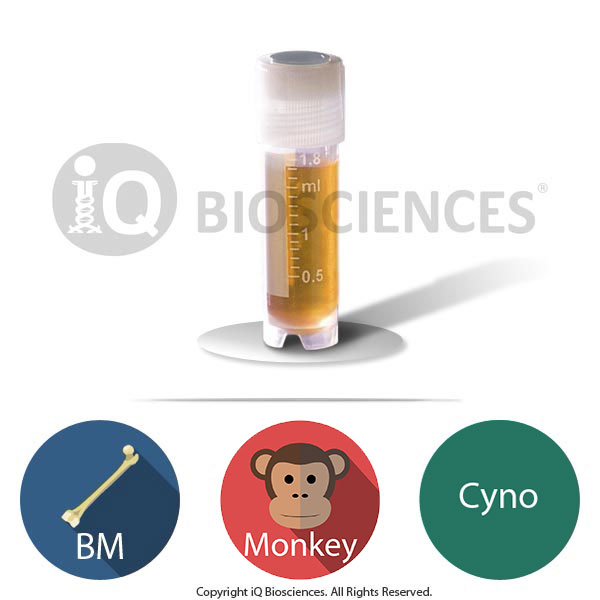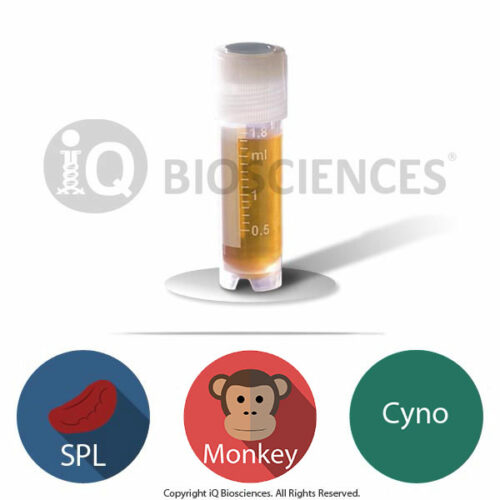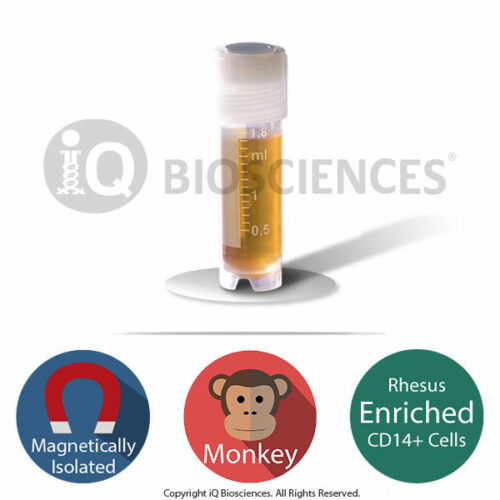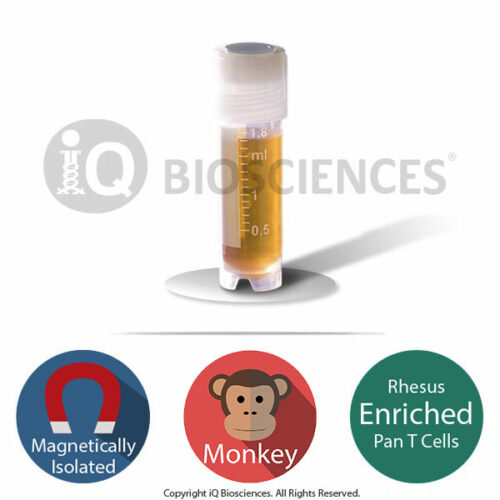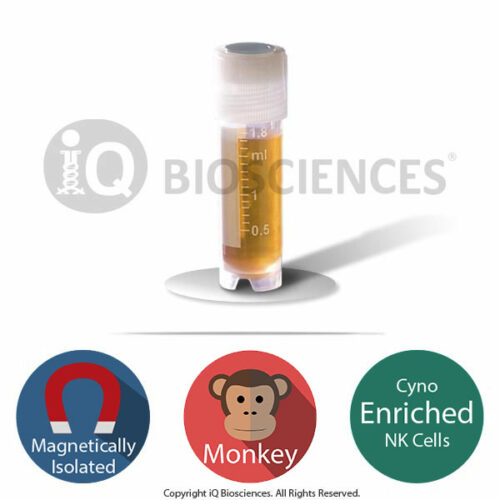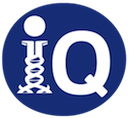- High-quality cynomolgus macaque bone marrow cells sourced responsibly from a vetted third party facility
- High viability (typically > 70%) after thaw
- Used for a wide variety of safety assessment and functional assays
- All orders come with an iQ Certificate of Analysis
- Normally ships out same business day
Cynomolgus Monkey Bone Marrow Cells
$490.00 – $1,460.00
- Description
- Additional information
- Donor Request
- Ethics
- iQ Experience
- Shipping Information
- Distributors
Description
About the Cynomolgus Monkey (or Cynomolgus Macaque)
Cynomolgus macaques are the most commonly utilized non-human primates in biomedical research. They are employed in numerous research areas, such as immunology, neuroscience, oncology, diabetes, and pharmacology due to their physiology.
Application Summary for Cynomolgus Monkey Bone Marrow Cells
Cynomolgus monkey bone marrow cells (or cyno bone marrow cells) can be used for a wide variety of safety assessment and functional studies. They are commonly employed in pre-clinical settings to ensure biologics are not eliciting unwanted effects or functions on the different cell populations of the bone marrow. Bone marrow cells are also utilized to test the toxicity of compounds on these cells. Additionally, cynomolgus bone marrow can be used in ex-vivo applications for cell population characterization.
Cynomolgus monkey bone marrow cells can also be used to generate mature monocytes and macrophages from progenitor cells in the marrow. These cells are then typically used in co-culture assays with other immune cells to assess their function.
Isolation of Cynomolgus Monkey Bone Marrow Cells
Bone marrow from cynomolgus monkeys is collected responsibly at third party facilities. These facilities are vetted to ensure they operate according to local regulations and laws. Since the facility is local, the marrow is quickly transported to iQ’s facility for processing.
At our facility, bone marrow is carefully removed from the tissue and mechanically dissociated to obtain a single cell suspension under sterile conditions. The suspension is carefully passed through a filter to remove any aggregates and subsequently depleted of red blood cells. The bone marrow is then frozen based on iQ Biosciences’ quality-controlled cryopreservation protocol to promote recoverability and viability once in the end user’s hands.
Cryopreservation and Storage
Our cyno bone marrow cells are cryopreserved carefully using iQ Biosciences’ cryopreservation protocol that ensures high viability (typically > 70%) after thawing.
Cells should be stored at < -120°C once they are received, such as within a liquid nitrogen tank (vapor phase).
Additional information
| Available Size(s) | 1 million cells / vial, 2 million cells / vial, 5 million cells / vial |
|---|---|
| Cell Type | |
| Species | |
| Format | |
| Tissue Type | |
| Viability | Typically > 70% |
We are happy to accommodate the following donor requests if inventory is available. Feel free to inquire prior to ordering, or specify your interest in the "Order notes" section during checkout and we will follow-up with your shortly after your order is processed:
- Single or multiple donors for a particular product (SKU). Indicate number of vials from each individual donor
- Donor-matched PBMCs
- Donor(s) with a higher percentage of the cells of interest, i.e., B cells, CD14+ cells, CD4+ cells, CD8+ cells, or NK cells (for PBMC products only)
We are Committed to Ethical Practices
iQ Biosciences’ primary cell products from non-human primates are collected under approved IACUC protocol, which was developed in consultation with the Attending Veterinarian and is consistent with current veterinary standards. The collection facility is AAALACi and PHS accredited, and all animal housing, handling, and research protocols are consistent with standards set forth by the Animal Welfare Act, NIH's Policy on Humane Care and Use of Animals and the Guide for the Care and Use of Animals. All animal housing and handling is done in such a way to minimize stress and risk of injury to the animal.
For US customers, we ship via FedEx Overnight Shipping. Shipping charges will vary per shipping address (based on ZIP code) and are estimated to be $140.
For international (non-US) customers, we work closely with you and our couriers to ensure all necessary documentation is in place for international shipments to significantly reduce the chance of delays at Customs. For the export of non-human primate samples, this includes preparing CITES permits, as well as any other documentation as required by country. Please submit an inquiry to orders@iqbiosciences.com for your estimated time of delivery and shipping charges.
Austria
Hölzel Diagnostika Handels GmbH
Tel: +49 221 126 02 66
Email: info@hoelzel.de
Web: https://www.hoelzel-biotech.com/
Canada
Cedarlane
Tel: +1 (289) 288-0001
Toll Free (North America): +1 (800) 268-5058
Fax: +1 (289) 288-0020
Email: sales@cedarlanelabs.com
Web: https://www.cedarlanelabs.com
China
BIOHUB INTERNATIONAL TRADE CO., LTD.
上海起发实验试剂有限公司
Address: Chuansha Rd #6619, Pudong, Shanghai, Zipcode: 201200 P.R.China
Tel: 0086-021-50724187
Phone: +86-15921799099
Fax: 0086-021-50724961
Email: sale3@78bio.com
Web: www.qfbio.com
European Union
Caltag Medsystems Ltd.
Email: office@caltagmedsystems.co.uk
Web: https://www.caltagmedsystems.co.uk
tebu-bio
Web: https://www.tebu-bio.com
Or Find a local contact
Germany
Hölzel Diagnostika Handels GmbH
Tel: +49 221 126 02 66
Email: info@hoelzel.de
Web: https://www.hoelzel-biotech.com/
Zageno
Web: https://zageno.com/
Ireland
2B Scientific Ltd
Tel: +44(0) 1869 238033
Fax: +44(0) 1869 238034
Email: sales@2BScientific.com
Web: https://www.2bscientific.com
India
Cell & Gene BioSolutions Pvt. Ltd.
#478 C, SLV Complex, Raghavendra Swamy Mutt Road
Opp. Turahalli Water Tank, Turahalli, Subramanyapura Post
Uttarahalli Hobli, Bengaluru-560061, Karnataka, India
Phone: +91 97317 14670
Phone: +91 98809 25033
Email: info@cgbios.com
Web: www.cgbios.com
Japan
Cosmo Bio Co., Ltd.
Tel: +81 (03) 5632 9610
Fax: +81 (03) 5632 9619
Email: nsmail@cosmobio.co.jp
Web: https://www.cosmobio.co.jp
Qatar
Sedeer Medical Services and Trading LLC
Tel: +974 4434 9191
Email: info@sedeer.com
Web: https://sedeer.com/
Singapore
Omnicell Pte Ltd
Tel: +65 6747 0201
Email: enquiry@omnicell.com.sg
Web: https://omnicell.com.sg/</a
South Korea
BioClone
Tel: +82-2-2690-0058
Email: bioclone@bioclone.co.kr
Web: http://www.bioclone.co.kr
Switzerland
Hölzel Diagnostika Handels GmbH
Tel: +49 221 126 02 66
Email: info@hoelzel.de
Web: https://www.hoelzel-biotech.com/
Taiwan
Hycell International Co. Ltd.
Tel: +886-2-2877-1122
Fax: +886-2-2876-1520
Web: http://www.hycell.com.tw
United Kingdom
2B Scientific Ltd
Tel: +44(0) 1869 238033
Fax: +44(0) 1869 238034
Email: sales@2BScientific.com
Web: https://www.2bscientific.com
Caltag Medsystems Ltd.
Tel: +44 (0)1280 827460
Fax: +44 (0)1280 827466
Email: office@caltagmedsystems.co.uk
Web: https://www.caltagmedsystems.co.uk
tebu-bio
Tel: +44 (0)1733 421880
Fax: +44 (0)1733 421882
Email: uk@tebu-bio.com
Web: https://www.tebu-bio.com
Zageno
Web: https://zageno.com/
United States
Fisher Scientific
Tel: 1-800-766-7000
Web: https://www.fishersci.com
Quartzy
Web: https://www.quartzy.com
VWR International
Tel: 1-800-932-5000
Web: https://www.vwr.com
Zageno
Web: https://zageno.com/
